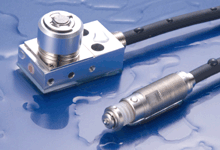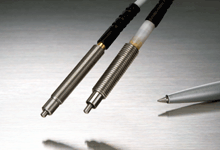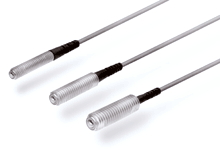METROLメトロル
Comparison of Contact Sensors and Non-Contact Sensors Brochure Download Brochure Download
| METROL Contact Sensor | Non-contact sensors (photoelectric sensors, proximity sensors) | |
| Signal point setting | The pre-travel is constant and the signal point is easy to adjust. The installation position can be marked on the CAD drawing. |
Signal point is not stable. Signal adjustment is difficult. |
| Signal point accuracy | Excellent repeatability (0.5-5 microns) | Cannot be marked, not accurate |
| Hardness of inspection surface | Contact parts are hardened, not easy to wear | Accidental impact can easily cause damage or cracks |
| Detect the condition of the surface | Detects the effects of surface water and oil | Dust, water and oil on the contact surface may cause signal errors |
| Material and shape of the object to be inspected | No limitation | There are restrictions (on material, shape, color, etc.) |
| Influence of external conditions | Almost none | Influenced by bright light, temperature and magnetic field |
| Mutual interference | No | Interference |
| Variation (temperature, voltage and time out of limits) | None (due to no amplifier) | Variation (due to amplifier) |
| Motion variation | No | With motion difference |
| Contact force | Contact force as small as 0.3N
(bottomed out due to lever action) |
No |
| Moving parts | Yes, high speed response is limited (5 times/second). Will cause wear of moving parts |
No, high response speed.。 No component wear problem. |
| Contact life | 1000 times of contact life can be achieved under low current and low voltage conditions.br> | No need to worry about contact life, but inrush current and impact on contact surface can cause failure. |
| Price range | Economical (no amplifier required)) | Expensive (amplifier required) |
Disadvantages of contact sensor
1、Mechanical moving parts
* There is a limitation of speed due to the quality response of mechanical moving parts
* In plunger type sensors, dust or other reasons between the plug bar and the bearing may cause the plug bar to jam, resulting in failure to output the signal properly.
(Signal failures are thought to be caused by contact problems, but in reality they are often caused by rod failures).
* he solution to this problem is to select the correct, IP protection level and choose the appropriate bearing structure according to the application.
* When using non-contact sensors, intermediate conductive parts are often used between the sensor and the object to be detected.br>
2、Contact force required (at least need to press the sensor)
* Contact sensors have better performance than non-contact sensors in position detection, but are not suitable for distance detection.
![]() MMT Touch Sensor-P Series
MMT Touch Sensor-P Series
 |
◎ 0.5 micron repeatability |
![]() MT Touch Sensor-CS Series
MT Touch Sensor-CS Series
 |
◎ 0.5 micron repeatability |
![]() Series of mechanical components with built-in sensors
Series of mechanical components with built-in sensors
 |
◎ One device can complete two tasks. |
![]() Mini Stopper with Built-in Sensor - STM Itoray
Mini Stopper with Built-in Sensor - STM Itoray
 |
◎ Φ8x8 (minimum size) Mini stopper with built-in sensor |
![]() Ball plunger with built-in sensor - BP series/strong>
Ball plunger with built-in sensor - BP series/strong>
 |
◎ Install the high-precision sensor into the ball plunger |
